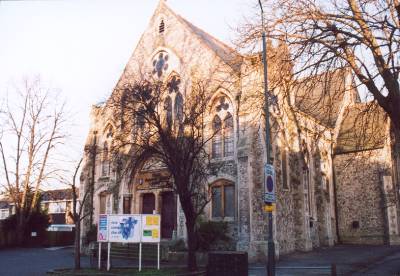 |
||||||||||||
|
|
||||||||||||
 |
|||
|
In one sense, the history of Emmanuel Church only dates from 1976 when Sidcup’s Methodist and United Reformed Churches joined forces under the combined ministry of Rev. Roy Crew and Rev. Baron Pont. Before then the two churches each had a separate existence. Congregational ChurchIn 1866 the construction of the railway and the opening of Sidcup Station brought a steady increase in population. With this rise came a need for more non-conformist places of worship to augment the Baptist Chapel on Sidcup Hill. In 1876 a meeting was held to consider the building of a Congregational Church and in 1878 the Congregational Lecture Hall was opened in Station Road. The Sidcup Congregational Church was formed in 1879. |
 |
|
In 1887 the foundation stone was laid for a new church in Station Road (opposite Victoria Road). The original proposed design included a large tower and spire on the left, but these were never built. The church opened in 1888 with room for 550 and a further 300 in a gallery. Methodist ChurchA group of Wesleyan Methodists sought to establish a church in Sidcup and the first service was held at Unity Cottage, Birkbeck Road in 1882. The first Methodist Church was built in 1884. This building is now the Church Hall of Emmanuel Church in Hadlow Road. |
 |
|
The membership of 53 in 1892 doubled in the next three years, showing that the chapel would soon be too small. A new church was built on the corner of Granville and Hadlow Roads, the present Emmanuel Church, and the old chapel became the Church Hall. The original design included a central spire, but this was never built. The church was built with room for 400 with the ability to increase this to 600. It cost £4400 and was opened on September 19th 1895. |
 |
|||
 |
|||
|
An important feature of the design was the suspended cross with its two shadows. It was made by Mr. Mitchell, the woodwork teacher of Craybourne school, using pine from surplus pews. After being stored in St Mary Cray Parish Church it was carried in procession to Sidcup by the Youth Club on Good Friday. United Church Regular united services were held in the two churches during the Second World War and they continued afterwards on an occasional basis. |
 |
|||||||||||
|
The interior of the church |
|||||||||||
 |
|||||||||||
|
The organ and pulpit |
|||||||||||
 |
|||||||||||
|
Millenium Pew Runners and Seat cushions |
|||||||||||
|
Blendon Cross The wooden cross from Blendon Church (a former church of the Methodist Circuit) was made from Japanese Oak in the Woodwork Department of Chislehurst and Sidcup Grammar School in the Spring Term of 1973. On Good Friday morning it was carried in procession to Blendon Church. It hung in the sanctuary there until Blendon was closed in August 2006, when it was moved to Emmanuel. It now hangs in the entrance, welcoming all worshippers to Emmanuel. |
|
Page last updated 26/8/21 Photographs by A Howard 2003 |
|
[Home] [Welcome] [Description] [Church Groups] [Services] [Location] [Links] [Hall Hire] [Coming/Recent Events] [Magazine] [Messy Church] |